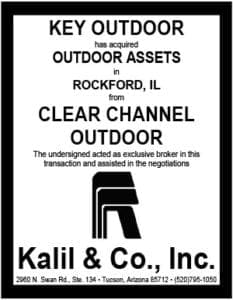
 Stephen Freitas OAAA Chief Marketing Officer
Stephen Freitas OAAA Chief Marketing Officer
This month’s question is: What are some of the most exciting opportunities ahead as the OOH industry converges with smart cities over the next several years?
 Kevin Bartanian, EVP of Sales & Business Development, StandardVision
Kevin Bartanian, EVP of Sales & Business Development, StandardVision
Smart city applications are designed to manage urban flows and allow for the city to interact with its citizens in real-time ultimately improving its livability. As more cities embrace the evolution of intelligent interconnectivity, tapping into OOH’s footprint becomes integral to the initiative.
Smart cities enable OOH to provide timely geo-specific safety information and services such as high-speed Wi-Fi access, information panels, and other must-have amenities to city visitors and residents. What I’m most excited about is the intelligent connectivity combined with human behavior that will provide powerful data, enabling our advertisers to anticipate needs and deliver personal experiences to our audience.
 Michael Galkin, Director of Marketing and Research, Branded Cities
Michael Galkin, Director of Marketing and Research, Branded Cities
As more and more cities look to be models in the technological age, OOH has a tremendous opportunity to reinvent advertising for a whole new generation of individuals. With facial and vehicular detection becoming more commonplace, the continued deployment of beacons and NFC touchpoints and the fact that 77 percent of Americans have a smartphone, many of which are location-identifiable, OOH is that much closer to the ideas presented in that Tom Cruise movie Top Gun. Umm, I mean Minority Report.
 Mike Gamaroff, SVP of Channel Strategy, SITO Mobile
Mike Gamaroff, SVP of Channel Strategy, SITO Mobile
The term “smart cities” refers to the technology-enabled science of consumer movement patterns and their interaction with the surrounding city services and structures. With improving knowledge of consumer movement comes deeper intelligence into the timing, positioning, and targeting of digital displays in cities. The more we learn about what consumer profiles are where and when, the more accurate and efficiently we display content to the right users at the right time. This efficiency will provide a proposition to cost-conscious advertisers that will level the playing field between DOOH and more preferred digital channels.
 Jeff Gunderman, President, EYE Corp Media
Jeff Gunderman, President, EYE Corp Media
Much of the technological advances enabling smart cities are the same or related to technological advances transforming the OOH industry.
According to Wikipedia, “A smart city is an urban development vision to integrate information and communication technology (ICT) and Internet of things (IoT) technology in a secure fashion to manage a city’s assets. A smart city is promoted to use urban informatics and technology to improve the efficiency of services.”
The exciting opportunities for the OOH industry stem from that ICT and the IoT technology enabling a much better understanding of audiences and the delivery of more relevant advertising and content through the OOH backbone but paired with mobile and digital. The exciting part is the true evolution of OOH to adapt and take advantage of the smart city infrastructure and in fact there should be opportunities to utilize the OOH infrastructure to better enable smart cities. I believe some of the most revolutionary and exciting opportunities are not even discovered yet!
 Stephanie Gutnik, Director of Business Development, BroadSign
Stephanie Gutnik, Director of Business Development, BroadSign
The synergy of OOH and smart cities enables communities to retain/build a local sense of and affinity to their unique identities, all in an efficient and environmentally-friendly way. JCDecaux’s sustainable and smart bus shelters in Paris are a great example, offering a custom design suited to the area, real-time traffic information, USB ports, and local advertising opportunities. Some even have solar panels and plant-covered roofs.
The two also work in tandem to keep urban areas safe – emergency messaging can be activated within 60 seconds! Given the importance of these communications, it is essential the network is running trusted and secure software so content remains in the appropriate hands.
 Alex Kim, Chief Partnerships Officer, Blue Bite
Alex Kim, Chief Partnerships Officer, Blue Bite
Cities have traditionally been the core of civilization. I’d argue that the definition of civilization should always include urbanization or urban development. Smart city initiatives spanning the globe are a natural progression in the evolution of the city. By 2050, two-thirds of the planet’s population will live in these cities.
With that said, OOH is essential within the framework of this movement. Historically, OOH has been underutilized but with leaps in technology, we’re able to exponentially enhance these fixtures to literally be the lifeline of an overpopulated city serving its citizens with essential utilities, as well as relevant information and services. The result is an intricate symphony of objects, devices, fixed infrastructure – all humming and working together to bring timely, informed, and personalized experiences to each and every one of us.
 Leslie Lee, Director of Marketing, Vistar Media
Leslie Lee, Director of Marketing, Vistar Media
There is enormous potential for the OOH industry to play a key role in supporting new smart cities initiatives. Adding in a monetization component through advertising can help offset the cost of installation and maintenance of new systems, helping city planners see these systems as revenue sources instead of pure cost centers. Furthermore, as more OOH networks digitize and invest in CMS and operations systems that allow for more flexible delivery of content, there will be new ways for city services, governments and private companies to engage with citizens (for example, we are already seeing OOH being leveraged for emergency notifications and AMBER Alerts; this could be expanded for further information sharing and more interaction). The OOH industry already has a wealth of data on the physical environment and consumer behaviors, and by adding in more sensory data collection points, OOH could truly become a research tool for city investment and planning.
 Mike Neel, Head of Marketing, AdMobilize
Mike Neel, Head of Marketing, AdMobilize
Many cities around the US are investing in smart infrastructure across the most critical functions and will continue to do so over the next few years. The opportunity I see for the OOH industry is that each OOH unit will essentially become a data hub for the city. If you think about it, each unit, be it a bus shelter and highway billboard, is almost always already perfectly positioned and built to leverage data aggregation technology to provide a city with comprehensive analytics about traffic, movement, and more. This will save cities time and money, and will allow OOH to increase its importance in the evolution of a smart city.

Mike Norton, EVP, Norton Outdoor
Many of the opportunities that lie ahead as OOH converges with smart cities include the incorporation of the data that will be available. Increased data will mean better predictive/proactive planning for OOH, but also more dynamic and responsive uses. While these opportunities aren’t necessarily unique to smart cities, as more data is becoming available and being used now, smart cities will provide better data at a faster pace.
 Sharon Peyer, Business Development, Crane Connectivity
Sharon Peyer, Business Development, Crane Connectivity
First, life of media rights extends as OOH gets more integrated into real estate and media owners invest in building structures like bus shelters, FOBs, etc. and hold the rights of media ownership.
Second, OOH assets migrate from standard billboards to aesthetic and smart street furniture, smart screens attached, or integrated into points of transit – media assets become both functional and aesthetic. Finally, OOH brings environmental benefits including “green advertising”, e.g. advertising panels with solar panels that reduce power usage and CO2 emission.
[wpforms id=”9787″]
Paid Advertisement

















